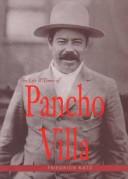Check nearby libraries
Buy this book

Based on decades of research in the archives of seven countries, this definitive study of Villa aims to separate myth from history. So much attention has focused on Villa himself that the characteristics of his movement, which is unique in Latin American history and in some ways unique among twentieth-century revolutions, have been forgotten or neglected. Villa's Division del Norte was probably the largest revolutionary army that Latin America ever produced.
Moreover, this was one of the few revolutionary movements with which a U.S. administration attempted, not only to come to terms, but even to forge an alliance.
The first part of the book deals with Villa's early life as an outlaw and his emergence as a secondary leader of the Mexican Revolution, and also discusses the special conditions that transformed the state of Chihuahua into a leading center of revolution. In the second part, beginning in 1913, Villa emerges as a national leader. The author analyzes the nature of his revolutionary movement and the impact of Villismo as an ideology and as a social movement.
The third part of the book deals with the years 1915 to 1920: Villa's guerrilla warfare, his attack on Columbus, New Mexico, and his subsequent decline. The last part describes Villa's surrender, his brief life as a hacendado, his assassination and its aftermath, and the evolution of the Villa legend. The book concludes with an assessment of Villa's personality and the character and impact of his movement.
Check nearby libraries
Buy this book

Previews available in: Spanish English
Showing 2 featured editions. View all 2 editions?
| Edition | Availability |
|---|---|
| 1 |
cccc
Libraries near you:
WorldCat
|
|
2
The life and times of Pancho Villa
1998, Stanford University Press
in English
0804730458 9780804730457
|
aaaa
Libraries near you:
WorldCat
|
Book Details
Edition Notes
Includes bibliographical references (p. [919]-954) and index.
Classifications
The Physical Object
ID Numbers
Source records
Scriblio MARC recordLibrary of Congress MARC record
Ithaca College Library MARC record
Internet Archive item record
marc_openlibraries_phillipsacademy MARC record
marc_openlibraries_sanfranciscopubliclibrary MARC record
amazon.com record
Better World Books record
Library of Congress MARC record
Internet Archive item record
Internet Archive item record
amazon.com record
marc_scms MARC record
Promise Item
Better World Books record
marc_nuls MARC record
marc_columbia MARC record
Work Description
The definitive biography of a Mexican revolutionary reckoned a monster by some, a hero by many more. Francisco Villa’s origins, writes University of Chicago historian Katz (The Ancient American Civilizations, 1972), have long been obscured in legend; Villa himself gave differing accounts of his rise. The sources seem to agree, however, that Villa was a minor bandit who managed through canny self-promotion to remake himself, as American president Woodrow Wilson put it, into “a sort of Robin Hood [who] had spent an eventful life in robbing the rich in order to give to the poor.” Katz places Villa’s rise to revolutionary leadership in the context of social unrest in 19th-century northern Mexico, when the comparatively wealthy state of Chihuahua attempted to break away from the rule of Mexico City, precipitating a nationwide power struggle. At the beginning of that revolution, Katz discovers, Villa had been working as a muleteer for an American mining company and was locally renowned for his knowledge of cockfighting; his chief ambition seems to have been to set up a butcher shop in the capital city. Instead, Villa took advantage of the unrest to raise an army to wage war against national leaders Francisco Madero and Porfirio Diaz. He also forged an unlikely alliance of the Chihuahuan oligarchy and the revolutionary peasantry, crossed into the US to raid arsenals and granaries, and ranged throughout Mexico to commit strategically innovative acts of guerilla warfare. Through misjudgments, however, Villa lost important battles in the north, and his army, now full of unwilling conscripts instead of volunteers, disintegrated in 1915. Assassinated in 1923 while staging an attempted comeback, Villa continues to influence Mexican politics after his death, with candidates even today invoking his name. Katz speculates that had Villa survived to lead the nation, he would have instituted important land reforms and established a more democratic government than the quasi-dictatorship that followed. An important, well-written contribution to Mexican history.
Links outside Open Library
Community Reviews (0)
Feedback?| August 6, 2021 | Edited by New York Times Bestsellers Bot | Add NYT review links |
| August 16, 2020 | Edited by ImportBot | import existing book |
| March 4, 2020 | Edited by mountainaxe1 | Edited without comment. |
| December 4, 2010 | Edited by Open Library Bot | Added subjects from MARC records. |
| December 9, 2009 | Created by WorkBot | add works page |












